› Forums › Variable Stars › Nova in Hercules
- This topic has 50 replies, 23 voices, and was last updated 1 year, 2 months ago by
 Gary Poyner.
Gary Poyner.
-
AuthorPosts
-
18 June 2021 at 5:03 pm #584380
 Alan ThomasParticipant
Alan ThomasParticipantI have just watched it. Very interesting. Also the presentation on the Unistellar eVscope.
Thanks
Alan
20 June 2021 at 8:27 pm #584381 Jeremy ShearsParticipant
Jeremy ShearsParticipantDown to about mag 11 as of today (June 20)
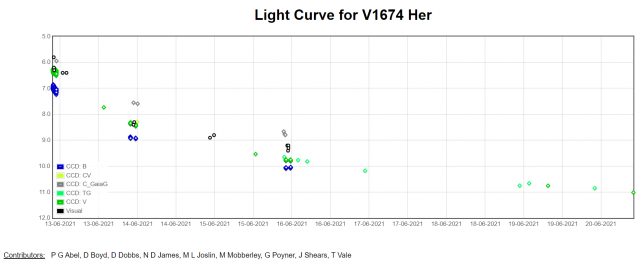 21 June 2021 at 7:55 pm #584383
21 June 2021 at 7:55 pm #584383 David BoydParticipant
David BoydParticipantThose following the class of this nova may be interested to know that the recent ATel 14728 has reported that it now looks more like a He/N nova than Fe II as was being reported by ATels up until June 16th. This change actually happened within 36 hours of its discovery on June 12.54 UT as this compilation of amateur spectra shows. Compare these with the spectrum of Nova Sgr 1991 in figure 2 of Williams, The Formation of Novae Spectra, AJ, 104, 725 (1992).
David

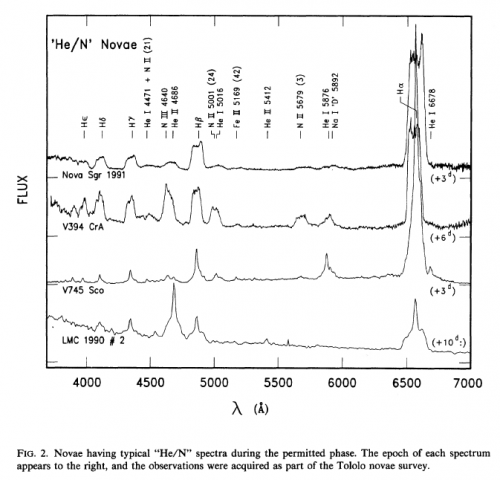 27 June 2021 at 7:25 am #584395
27 June 2021 at 7:25 am #584395Mr Andrew Jeffries
ParticipantAfter hearing of the discovery of another nova and with the best chance I’d had in two weeks, I went hunting for it last night 27 June. This was a lesson in the value of good polar alignment as I ended up using co-ordinates rather than star hopping. After comparing my image with charts I managed to locate it and with Jeremy Shears magnitude estimate from last week I can see I almost missed this one.
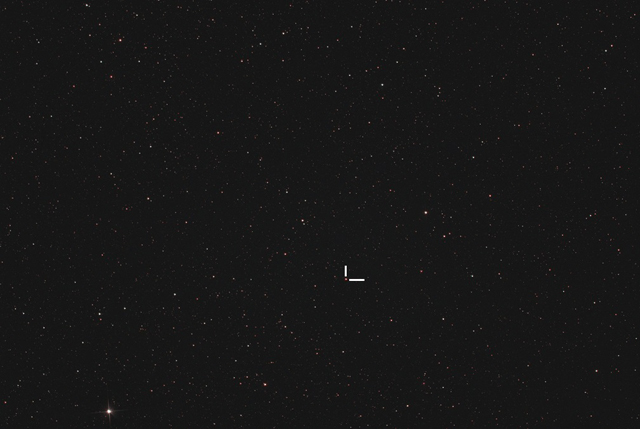 25 July 2021 at 5:36 pm #584509
25 July 2021 at 5:36 pm #584509 Jeremy ShearsParticipant
Jeremy ShearsParticipantStill worth following this nova in her while the field is well placed. Fading the mag 15 now, though, but perhaps leveling off:
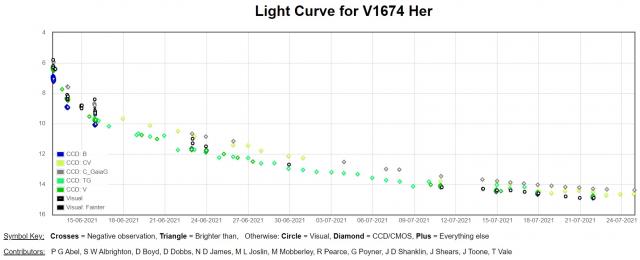 29 August 2021 at 2:29 pm #584630
29 August 2021 at 2:29 pm #584630 Robin LeadbeaterParticipant
Robin LeadbeaterParticipantNow at mag 16 but still within range of a very low resolution spectrum with the ALPY200.
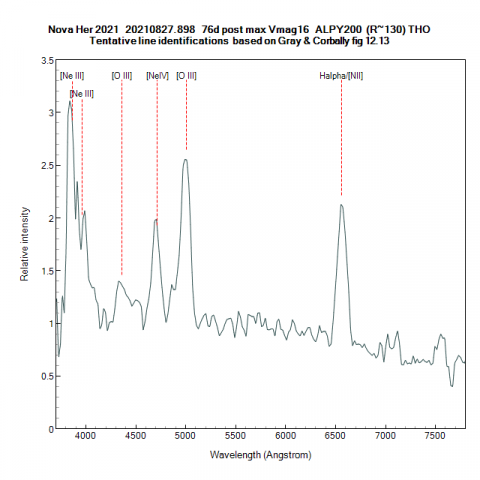
The spectrum with several forbidden nebula lines looks similar to that of another very fast nova Sgr 1991 at similar age in Gray & Corbally , where the tentative line identifications come from
Cheers
Robin
8 January 2022 at 1:38 pm #585100 Jeremy ShearsParticipant
Jeremy ShearsParticipantUpdated light curve until end 2021. Currently 17th mag
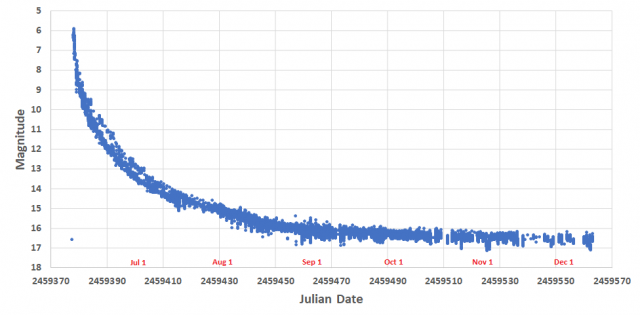 12 April 2022 at 10:38 am #609678
12 April 2022 at 10:38 am #609678 Jeremy ShearsParticipant
Jeremy ShearsParticipantThe nova, V1674 Her, is still 3-4 magnitudes above quiescence (latest entry in VSS database: Apr 2 at mag 16.7 by Nick James) as shown in the accompanying light curve. Well worth following now that Hercules is more readily accessible. As Prof Joe Patterson (Columbia U and Center for Backyard Astrophysics) noted: “We are just getting started on this amazing star… and I bet others are, too. In the history of novae, I think it will take a high place in the pantheon, alongside DQ Her, T Pyx, and V1500 Cyg”
A recent ATel (https://www.astronomerstelegram.org/?read=15312) said optical spectroscopy suggests it has returned to quiescence, which is curious since the progenitor was 20.5g. The final chapter on this neon nova is far from being written…..
Attachments:
12 April 2022 at 12:31 pm #609680 Daryl DobbsParticipant
Daryl DobbsParticipantIt’s certainly an interesting object, there is another Atel telegram posted after the one above, ( I posted both on the BAA Twitter and Facebook pages) which indicate modulation in X-Rays
https://www.astronomerstelegram.org/?read=1531723 October 2024 at 10:33 am #626029 Jeremy ShearsParticipant
Jeremy ShearsParticipantMany people enjoyed the nova V1674 Her that erupted in 2021 (was it really that long ago?). A pre-print of an ApJ paper has just appeared which probes the early part of the eruption in unprecedented detail, shedding now light on the events at the white dwarf that triggered the eruption.
24 October 2024 at 8:27 am #626054 Gary PoynerParticipant
Gary PoynerParticipantThanks for alerting us to this Jeremy. A really cracking Nova! Just linked this to CVnet.
Gary
-
AuthorPosts
- You must be logged in to reply to this topic.

